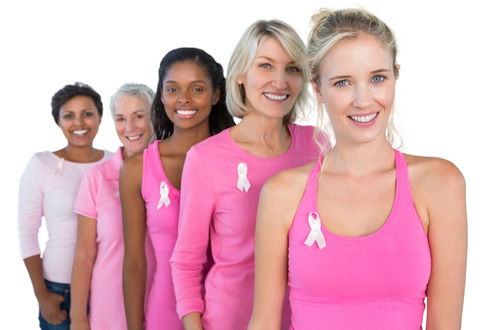The natural approach to Breast Cancer

One in eight women in the US develops breast cancer, and the number of breast cancer patients is increasing year after year. One-third of all cancers in women are breast cancer. The mortality rate of breast cancer is second only to lung cancer.
Risk factors for breast cancer
You may be at an higher risk for breast cancer if you are an older woman, have a history of cancer in your family, carry excess weight, consume a diet high in fat, drink alcohol excessively, began menstruating early, are in late menopause, are childless and or were over age 40 during your first pregnancy, use birth control pills or have hormonal imbalances.
There is a low risk of breast cancer among Japanese women; however, the fact that Japanese women who move to the US are likely to develop breast cancer as often as American women shows that lifestyle and diet can greatly affect a woman’s breast cancer risk.
Estrogen and breast cancer
Estrogen is one of the female hormones and is a known factor in breast cancer. Estrogen can be roughly divided into two types: Estrogen produced in women’s bodies, and estrogen that enters the body via oral contraceptives, hormone replacement therapy, or environmental sources.
Among the many environmental hormones, most of them come from plastic. Environmental hormones leach out from plastic containers into food when plastic is heated or is in contact with acidic food and oil. Also, hormones contained in foods such as meat, eggs, and dairy foods can affect your health. The use of estrogen to promote livestock growth has been carried our extensively in the US, though the practice is inhibited in Japan and Europe.
If you start using oral contraceptives at young age and use them for many years, you may be at an increased risk of developing breast cancer. There is data that showing that hormone replacement therapy for treating menopausal conditions for longer than 5 years increases the risk of breast cancer by 25%. Since the hormone used for conventional hormone replacement therapy has a totally different structure from the one produced in the female body, its toxicity rises.
The estrogen produced in the female body can be divided into three types: Estrone (E1), Estoradiol (E2), Estriol(E3). Each one has different functions. E1 and E2 have a strong estrogenic activity, and also increase breast cancer risk; E1 poses the greatest risk. On the other hand, E3 does not have strong estrogenic activity, but helps protect the body from the risk of E1 and E2. Therefore, the proper ratios among E1, E2 and E3 are very important for breast health. Since Estrone (E1) is produced not only in the ovaries but also in fat, proper weight control is important to reduce excessive production of E1.
There are also estrogen metabolites that increase or decrease the risk of breast cancer. The ratio of metabolites can be improved by diet and lifestyle. If you want to know your own breast cancer risk – especially if you have family history of it or have had breast cancer before – a special test is strongly recommended to check the ratio of estrogen and metabolites in your urine.
Diagnosis of breast cancer
There are no symptoms during the first stage of breast cancer; the disease progresses silently. Since the tumor must be 25mm in size to be noticeable by physical touching, tumors are not easy to find in their early stage. It is important to get regular physical checkups at a medical facility. Mammography is a specific technique used to find breast cancer, and is recommended once a year for female over 40. Mammography can find tumors 15mm in size. Some 85% of breast cancers can be found using mammography, which statistically means that 15% of tumors cannot found because they are too small. MRI and CT scans can find very small breast cancers of 1mm. However, this equipment is not used for regular physical checkups, because it is quite expensive to use and exposes the patient to radiation (in CT).
There is a higher survival rate for women when tumors are found at an early stage. One study shows the survival rate is about 95% if the cancer is discovered when it is 10mm or smaller in size.
To prevent breast cancer:
Avoid:
. Fatty foods
. Hormones added to meat, egg and dairy products
. Heating plastic containers in microwave ovens
. Drinking alcohol
. Smoking
Use supplements such as:
. Carotenoids
. Vitamin A
. Folate
. Selenium
. Dietary fiber
What to eat:
. Olives
. Flax seeds
. Beans and legumes
. Broccoli
. Green tea
And, last but not the least, exercise regularly and control your weight.
Natural Medicine for breast cancer
Natural medicine is also a big help to breast cancer patients. It can improve the immune system, help with quality of life, and decrease the side effects of chemotherapy. Natural medicine is also great to prevent relapses of cancer. Ginger, Ginseng, Astragalus, Green tea, and Quercetin can decrease the side effects of chemotherapy. Recent research shows that Astragalus, Cat’s claw, Ashwaganda, and Coriolus versicolor are very effective in boosting an immune system weakened by chemotherapy. Indole-3-carbinol is very effective for improving the metabolites of estrogen, and it is found in high amounts in broccoli or the Brassica family.
The most important way to prevent a cancer relapse is to improve your lifestyle. Lifestyle changes eventually improve your estrogen ratio and estrogen metabolites.
If you want to use herbal medicine and supplements in combination with conventional cancer therapy, consult a doctor who is familiar with natural medicine in advance. In some cases, combining the two treatment types might reduce the effectiveness of chemotherapy.

